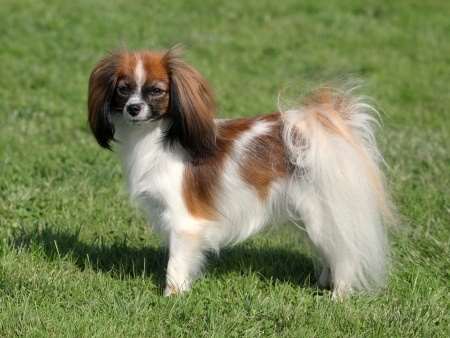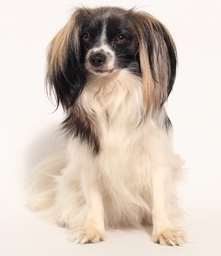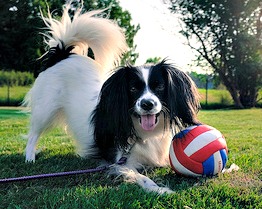The Phalène Dog
Phalène by Janice Jones |Last Updated January 24, 2020
In the dog world, we often get hung up by terminology and different names to call a certain breed. Depending on your country, the Phalène can be a separate breed recognized by the Fédération Cynologique Internationale (FCI) or another form of the Papillon with droopy ears (AKC).
Whether you like your dog’s ears to hang low or stand up is a matter of personal preferences. Both the Papillon and the Phalène are the same type of dog except for the ear carriage.
 Phalène
PhalèneThe Phalène predated the Papillon and was considered the first form of the breed dating as far back as the 15th century where the little dog is depicted in early paintings. Derived from the French, Phalène meaning “moth” this breed was the most popular type purported to have been owned by Marie Antoinette.
The Papillon later gained more popularity and the Phalene slowly declined in admiration. They are now making a comeback in many parts of the world.
Whether you are describing a Phalène or a Papillon, the story is the same. They are outgoing, affectionate and highly intelligent.
Both a lap dog and an energetic athletic, expect few dull moments if you share your home with this breed. They are quick and need a decent amount of exercise and mental simulation. But they can keep their muscles and brains in shape through rough and boisterous play in the back yard or a room in a cozy apartment.
This dog is always ready to play, take long walks, or participate in dog sports such as agility, obedience, or conformation.
His keen mind makes the breed a pleasure to train. They learn quickly, eager to please, and will do extremely well in obedience, or just plain learning new tricks to delight your friends.
Quick Facts: The Moth Dog, Butterfly Dog
Other Names Used: Moth Dog, Papillon
Affiliation: AKC, CKC, KC: Toy Group
Size
Height: 8 to 11 inches (20 to 28 cm)
Weight: 7-9 pounds (3 – 5 kg)
Coat Type: Single coated, silky and straight
Colors: Always multicolored which includes white with black, lemon, red, tan, brown, sable or silver.
Country of Origin: France, Belgium, Spain
Activity Level: Moderate
Life Expectancy: 12 to 16 years
Good with Children: Yes (Older children)
Good with other pets: Yes if raised together
History of the Phalene
 Phalène
PhalèneThe exact origin of this breed is unknown, but most believe the originated in France, Belgium, and Sapin. The information, we have about the breed, is seen in Old Masters paintings, where the little dog sits by his owner’s side.
They lived in nobles’ homes, keeping their laps warm and catching a rat or mouse occasionally. It is believed that the modern Phalene and Papillon descended from the Continental Toy Spaniel first the Phalene and then the Papillon.
The Phalene was most popular until the 19th century when erect ears became fashionable. From then on, the Papillon with their full, erect ears became more familiar and the less popular droop ear Phalene almost died out.
Papillon means “Butterfly” in French and refers to the full ears resembling a butterfly. It was around this time that the name, Papillon began being used. By the 1920s, it was nearly impossible to find a Phalène.
The erect ear variety became dominant, so breeding a dropped ear became harder and harder.
In recent years, there has been some concern about reviving the older droop ears, but as of now, both the Papillon and the Phalene are grouped together under the name Papillon with the American Kennel Club.
In countries where the FCI guidelines are used, both varieties are considered separate breeds.
Personality
 Courtesy Johan Larsson Creative Commons
Courtesy Johan Larsson Creative CommonsIf your ideal dog is highly intelligent, learns quickly and loves to please, this may be the perfect breed.They get along well with people and become loyal, devoted companions. Some may be reserved with strangers, at least at first, but the well socialized Phalene can learn to be friendly and get along with other dogs, as well as people.
At home, the Phalene is playful and affectionate, loving to keep your lap warm or accompanying you on a long walk. The Phalene is one breed where you can have it all—a snugly companion, an athlete, an easy dog to train, and an overall good family dog.
They require the attention of their owners and will shower you with kisses. But with all these positives, is there a downside?
They are active, so the perfect owner will be someone who enjoys a daily walk or an energetic romp in the park. Phalenes make excellent watch dogs and will alert you if they hear something.
Not considered yappy, they do their fair share of vocalization, and some cannot differentiate the ordinary noises of outdoors to that of someone coming to your house.
They learn quickly, but like many small dogs, housebreaking can be a problem. They are also known for the occasional stubborn streak. They do well with other pets if they are raised together and will do well with children who are gentle and respect his little body.
The Phalène does not understand his size and will try to jump from high places or take on a larger dog. These small dogs need to be supervised carefully around even friendly big dogs as they can get hurt quickly.
They prefer being indoors with their owners and would not do well left outside, especially in cold weather. Their single silky coat makes them more sensitive to cold temperatures. They do shed, so this may not be an excellent breed for those who have sensitives to dog hair or for those who do not want to see dog hair over the house.
Grooming
The Phalene has a single coat that is silky and straight in texture, but does shed. Grooming is not as difficult as it might at first seem, but regular brushing will keep the shedding down to a minimum.
The coat needs to be bathed and dried with a blow dryer. Express the anal glands while the dog is in the bath. Don’t put your face closeby when expressing these glands, because they tend to squirt out and leave a bad smelling scent.
Ears will need periodic cleaning.
Dental care is crucial in this breed because tarter tends to build up frequently. Daily brushing with a small amount of dog toothpaste is highly recommended. Daily dental care will not eliminate the need for professional cleaning and dental care, but it will assure that you reduce the number of trips to the vet for tooth related problems.
Health
The Phalene or Papillon is similar to other small breed dogs in that they enjoy a long life span and are relatively healthy.
Some conditions occur in this breed and are likely genetic in nature.
Patellar Luxation: A common problem in toy breed dogs, Patellar luxation or slipping knee caps, is a condition where the knee cap pops in and out of place.
Progressive Retinal Atrophy (PRA) One of the most common causes of blindness in dogs.
Periodontal Problems: When teeth do not receive regular brushing, tarter builds up causing inflamed gums and tooth loss.
Liver Shunt: A congenital problem where there is a reduced or absence of blood flow through the liver. A shunt is presented that redirects the blood away from the liver.
Neuroaxonal Dystrophy (NAD): Progressive neurodegenerative disorder is leading to death.
Pros:
- Highly intelligent
- Good Family Dog: Loyal Companion
- Easy to Train
- Good Watch Dog
- Easy to Groom
Cons:
- Tends to be vocal
- Sheds
- May not be a good choice for Allergy sufferers
- Maybe stubborn at time
Did You Know...
Stanley Coren, neuropsychologist, British Columbia professor, and author of The Intelligence of Dogs: A Guide to the Thoughts, Emotions, and Inner Lives of Our Canine Companions assessed and ranked 110 breed based on training ability.
The Papillon/Phalene was ranked #8 in intelligence.
Breed Club
The Papillon Club of America
About Janice (author and voice behind this site)
Having lived with dogs and cats most of her life, Janice served as a veterinary technician for ten years in Maryland and twelve years as a Shih Tzu dog breeder in Ohio.
Her education includes undergraduate degrees in Psychology with a minor in biology, Early Childhood Education, and Nursing, and a master's in Mental Health Counseling.
She is a lifelong learner, a dog lover, and passionate about the welfare of animals. Her favorite breed for over 50 years has been the Shih Tzu, but she has also lived with Poodles, Maltese, Yorkshire Terriers, Beagles, English Bulldogs, Carin Terriers, and a Cocker Spaniel.
When not writing, reading, and researching dog-related topics, she likes to spend time with her eight Shih Tzu dogs, husband, and family, as well as knitting and crocheting. She is also the voice behind Miracle Shih Tzu and Smart-Knit-Crocheting
Does This Article Deserve Your Thumbs Up?
We always appreciate your support and encouragement. Your thumbs up means so much to us. Please like this article.
If you find this page or any page on Small Dog Place Helpful, or useful in anyway, I'd love it if you would click the small heart found on the bottom right of each page.
You can also share or bookmark this page -- just click on the:

Free Monthly Newsletter
Sign Up for Our Free Newsletter and get our Free Gift to You.
my E-book, The Top 10 Mistakes People Make When Choosing a Dog (and how to avoid them)

